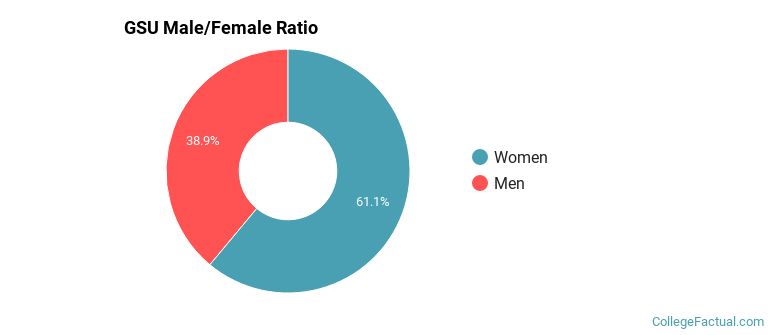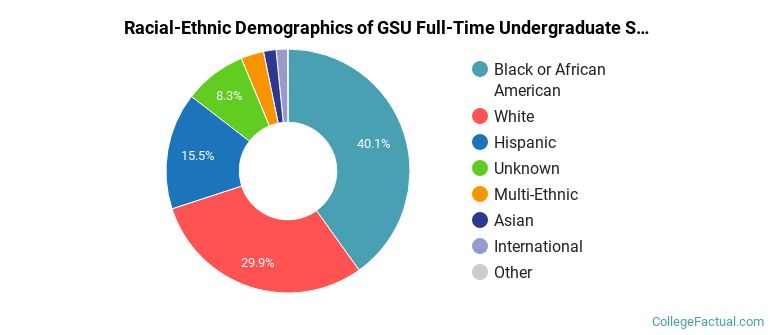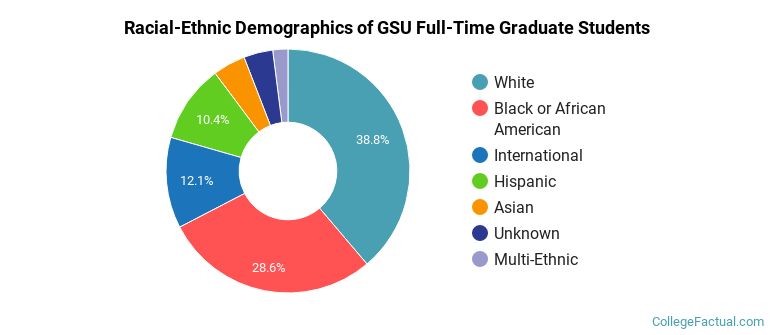 by our College Data Analytics Team
by our College Data Analytics TeamGSU total enrollment is approximately 4,650 students. 1,829 are undergraduates and 685 are graduate students.
Male/Female Breakdown of Undergraduates
The full-time GSU undergraduate population is made up of 64% women, and 36% men.

For the gender breakdown for all students, go here.
GSU Racial/Ethnic Breakdown of Undergraduates

| Race/Ethnicity | Number |
|---|---|
| Black or African American | 713 |
| White | 555 |
| Hispanic | 335 |
| Unknown | 108 |
| Multi-Ethnic | 55 |
| Asian | 35 |
| International | 24 |
| Native Hawaiian or Pacific Islander | 1 |
See racial/ethnic breakdown for all students.
Male/Female Breakdown of Graduate Students
About 68% of full-time grad students are women, and 32% men.

For the gender breakdown for all students, go here.
GSU Racial-Ethnic Breakdown of Graduate Students

| Race/Ethnicity | Number |
|---|---|
| White | 267 |
| Black or African American | 179 |
| International | 94 |
| Hispanic | 60 |
| Unknown | 40 |
| Asian | 30 |
| Multi-Ethnic | 15 |
| Native Hawaiian or Pacific Islander | 0 |
See racial/ethnic breakdown for all students.

| Race/Ethnicity | Number |
|---|---|
| Black or African American | 1,784 |
| White | 1,494 |
| Hispanic | 691 |
| Unknown | 283 |
| International | 150 |
| Asian | 122 |
| Multi-Ethnic | 120 |
| Native Hawaiian or Pacific Islander | 2 |

There are approximately 3,103 female students and 1,547 male students at GSU.
GSU ranks 1,903 out of 2,183 when it comes to geographic diversity.
1.83% of GSU students come from out of state, and 0% come from out of the country.

The undergraduate student body is split among 4 states (may include Washington D.C.). Click on the map for more detail.

| State | Amount |
|---|---|
| Illinois | 214 |
| Indiana | 2 |
| Georgia | 1 |
| Kentucky | 1 |
| Alaska | 0 |
Students from 19 countries are represented at this school, with the majority of the international students coming from India, China, and Nigeria.
Learn more about international students at GSU.
A traditional college student is defined as being between the ages of 18-21. At GSU, 13.81% of students fall into that category, compared to the national average of 60%.

| Student Age Group | Amount |
|---|---|
| 35 and over | 1,455 |
| 22-24 | 1,211 |
| 25-29 | 1,192 |
| 30-34 | 564 |
| 20-21 | 466 |
| 18-19 | 250 |
| Under 18 | 0 |
Footnotes
*The racial-ethnic minorities count is calculated by taking the total number of students and subtracting white students, international students, and students whose race/ethnicity was unknown. This number is then divided by the total number of students at the school to obtain the racial-ethnic minorities percentage.
References
Department of Homeland Security Citizenship and Immigration Services
Image Credit: By User:Astuishin under License
Find out how College Factual created their Diversity Rankings.